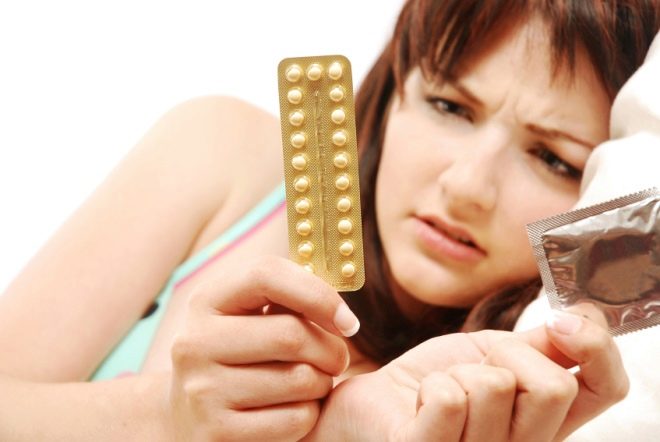When does menstruation usually begin after cesarean section?
The question of restoring the menstrual cycle after childbirth is always quite complicated and ambiguous. Especially a lot of questions arise in women who give birth by caesarean section. Allocations take a long time, it is not always clear whether menstruation has already begun or not and when to wait for them. In this article we will talk about the features of the restoration of the menstrual cycle after cesarean section.
Recovery time
During pregnancy, a large amount of the hormone progesterone is produced in a woman’s body, which helps her carry her baby. After birth, progesterone is reduced to a minimum, in the first place there are other hormones - oxytocin and prolactin. The first helps the uterus to involution to its former size, decrease, the second contributes to the formation of lactation for feeding the baby.
The onset of menstruation is a 90% hormonal process, and only to a small extent is it curled from the restoration of the tissues and cells of the uterus, its epithelium. As soon as the hormonal background comes to normal, the ovaries begin to work, which were suppressed by hormones during pregnancy and the maturation of the new eggs did not occur;
The exact time of the onset of menstruation you can not call any doctor, because the process of hormonal regulation and the individual characteristics of one puerperal completely different from the analogous criteria for another.
Most often in women who do not breastfeed for some reason and their babies are artificially fed, the body does not have a large effect of prolactin, and therefore their menstruation is more predictable. They come when the uterus is cleared of lochia and hormones begin to stand out according to the usual pattern: follicle-stimulating - lutein - progesterone - estrogen. Most often, the first menstruation in the absence of breastfeeding begins 2-3 months after surgery.
Nursing moms are not so straightforward, and we will describe this in more detail below.
Discharge after surgery - what is it?
The fact that many women mistakenly call menstruation after childbirth is called “lochia” in the language of doctors. They stand out from the moment of birth within 6-8 weeks, regardless of the type of birth - natural or surgical. After a cesarean section, however, lochia will usually stand out somewhat longer.
Menstrual blood is the epithelial cells that have grown in anticipation of the implantation of the embryo, but in its absence it is rejected by the body. In the monthly fluid a lot of enzymes, special substances, cervical mucus, intrauterine fluid. Lochia is the blood that is excreted from the placental wound. After separation of the placenta, the blood vessels fused with the uterus, the wound is inevitable, and, unlike the incisions, it cannot be sutured.
Blood clots in lochia are a sign of the beginning of blood clotting on the wound surface. After 5-6 days in the discharge after the operation, the tumor appears, in a week - mucus. As a rule, two months after cesarean section, the discharge becomes normal.
With the end of the withdrawal, the lochy uterus is reduced to its normal size and weighs about 50-70 grams. Her cavity is being cleaned.In theory, she is ready to conceive again, but this readiness is signaled by the arrival of regular menses. It is clear that you do not need to get pregnant right away in any case, because the process of restoring the uterine scar is longer and very important for carrying the next baby. It is simply a fact that is conceived by nature, and no more.
Differences from the usual menstruation
Lochia and regular menstruation cannot be mixed up. Between them there is always a fairly large timeout. If the postorum discharge is over, and after a couple of days they started with a new force, then this is not menstruation, but a possible postoperative complication, infection, inflammation, impaired uterine contractility, problems with scar healing.
Monthly come by and large spontaneously. The cycle will not be the same as before pregnancy, the day of menstruation will change. The discharge in the first menstruation may be more scarce than it was before pregnancy. This is due to the physiological depletion of the inner functional layer of the uterus - the endometrium. The first menstruation can last for a couple of days for the same reason. But a month after it, with repeated menstruation, the cycle will gradually level off and return to the usual for a woman parameters of duration, frequency, abundance of discharge and the presence or absence of premenstrual syndrome.
What is affected?
In addition to hormonal and rehabilitation factors that affect the restoration of the menstrual cycle, Other circumstances affect the timing of the onset of menstruation.
- Psychological condition of the puerperal. In a depressed woman, in a state of postpartum depression, the cycle recovers much longer.
- Age. In young girls, the menstrual cycle after cesarean section is restored several times faster than in women who have given birth after 35 years.
- Lifestyle. Chronic lack of sleep, malnutrition and vitamin deficiencies in the body, anemia, smoking and alcohol intake can significantly delay the recovery of the female cycle.
- Reception of medicines. If, due to various reasons, a woman was treated for a long time with antibiotics, hormonal drugs, took anticonvulsants, you should not count on the early arrival of menstruation.
In lactating women, menstruation begins later than in those who do not breast feed a child. The case of the hormone prolactin, which is produced during lactation and is part of breast milk. And in this the women who gave birth themselves, and those who had the delivery operation, are no different. Prolactin has a pronounced inhibitory effect on the production of progesterone, and without this hormone, the ovaries cannot fully function. Thus, the maturation and release of the egg from the follicle does not occur, there is no menstruation.
The more often the baby sucks the breast, the more often the mother feeds the baby on demand, the more prolactin is produced and the longer the menstrual cycle can be postponed.
At about six months, the mom, on the advice of a pediatrician, begins to add to the baby complementary foods. Breast milk begins to consume a smaller amount, which leads to a decrease in its formation and a decrease in prolactin. Progesterone begins to gradually recover in its rights, and about a couple of months after the start of the introduction of complementary foods, menstruation begins (the timing is rather arbitrary).
Women who have infants from birth are mixed feeding (breast milk + adapted milk formula), menstruation begins earlier - up to six months after the operation. Those who are against feeding and prefers to breastfeed their babies only with their breasts may not see their periods for more than a year.
When do I need to see a doctor?
The reason for going to the doctor and finding the causes of irregularities can be the absence of menstruation for six months, if the woman is not breastfeeding, or for a year, if she is breastfeeding and using complementary food for baby food.
The first 2-3 cycles since the onset of menstruation may differ with some irregularity. But if within six months from the first menstrual cycle did not become regular, it is necessary to consult a doctor.
You also need to go to the doctor if your period after cesarean is very painful, it is difficult, with fever, deterioration of health, severe pain in the lower back and lower abdomen. Unusual discharge — menstrual flow with foam, a strong unpleasant odor, the presence of large blood clots — all need to be examined and treated should be alerted.
About contraception
The absence of menstruation after cesarean section during breastfeeding is not a contraceptive method. The fact is that a woman cannot feel or notice the moment in which progesterone starts producing again due to a small fluctuation in the level of prolactin. And it is at this point that the maturation of the first egg after birth can begin. Lack of contraception at this point may lead to unplanned pregnancy.
Women after cesarean section are advised to refrain from such situations. at least 2 years. This is important for the complete formation of the uterine scar, for the restoration of the whole organism. Even abortion during these two years will have a very negative impact on the condition of the internal scar, and therefore it can be untenable, heterogeneous.
With such a scar, it will then be harder to get pregnant, harder to bear a child, since the likelihood of miscarriage, low abnormal attachment of the placenta, fetoplacental insufficiency and delayed fetal development increases. A thin and inconsistent scar will not allow a woman to give birth to a second baby by herself after the first cesarean section; He can not stand and break up during gestation, and this is fraught with death and for the fetus, and for mom.
Sexual intercourse in the first two months after surgery is contraindicatedbecause they create the danger of mechanical injury to the scar, as well as increase the likelihood of infection in the genital tract and uterus from the outside. After the lochia stops, you need to use a condom for intimate contact. Barrier contraception is extremely important until the moment when the menstrual cycle is fully restored and becomes regular.
After that, a woman should visit the gynecologist and discuss other methods of contraception with him if the condoms for some reason do not like the partners. Planning for the next pregnancy should be approached with all possible responsibility.
How to promote cycle recovery?
In the postoperative period, the woman must follow all the recommendations of the doctor. Do not lift weights, do not make sudden jumps, falls. You should not use tampons, for the rehabilitation period it is better to use sanitary pads.
Throughout the recovery period, it is important to eat fully. A woman needs a sufficient amount of protein foods and vitamins to restore the cycle. That is why it is better to postpone diets, gym visits and other “charms” to bring yourself beloved into shape after giving birth until the first menstruation or six months after surgical delivery.
About when menstruation begins after cesarean section, see the following video.
























